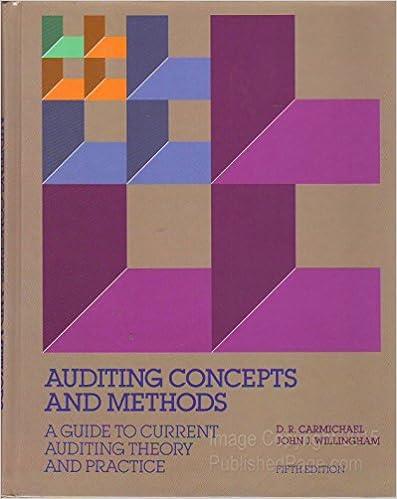The following questions relate to audit procedures for inventories. Select the best response. a. For several years
Question:
The following questions relate to audit procedures for inventories. Select the best response.
a. For several years a client's physical inventory count has been lower than what was shown on the books at the time of the count so that downward adjustments to the inventory account were required. Contributing to the inventory problem could be deficiencies in the internal control structure that led to the failure to record some
1. Purchases returned to vendors.
2. Sales returns received.
3. Sales discounts allowed.
4. Cash purchases.
b. An auditor has accounted for a sequence of inventory tags and is now going to trace information on a representative number of tags to the physical inventory sheets. The purpose of this procedure is to obtain assurance that
1. The final inventory is valued at cost.
2. All inventory represented by an inventory tag is listed on the inventory sheets. \
3. All inventory represented by an inventory tag is bona fide.
4. Inventory sheets do not include untagged inventory items.
c. When an auditor tests a client's cost accounting system, the auditor's tests are primarily designed to determine that
1. Quantities on hand have been computed based on acceptable cost accounting techniques that reasonably approximate actual quantities on hand.
2. Physical inventories are in substantial agreement with book inventories.
3. The system is in accordance with generally accepted accounting principles and is functioning as planned.
4. Costs have been properly assigned to finished goods, work in process, and cost of goods sold.
d. An inventory turn-over analysis is useful to the auditor because it may detect
1. Inadequacies in inventory pricing.
2. Methods of avoiding cyclical holding costs.
3. The optimum automatic reorder points.
4. The existence of obsolete merchandise.
e. When an outside specialist has assumed full responsibility for taking the client's physical inventory, reliance on the specialist's report is acceptable if
1. The auditor is satisfied through application of appropriate procedures as to the reputation and competence of the specialist.
2. Circumstances made it impracticable or impossible for the auditor either to do the work personally or observe the work done by the inventory firm.
3. The auditor conducted the same audit test and procedures as would have been applicable if the client employees took the physical inventory.
4. The auditor's report contains a reference to the assumption of full responsibility.
Step by Step Answer:

Auditing Concepts And Methods A Guide To Current Auditing Theory And Practice
ISBN: 9780070099999
5th Edition
Authors: Mcgraw-Hill





